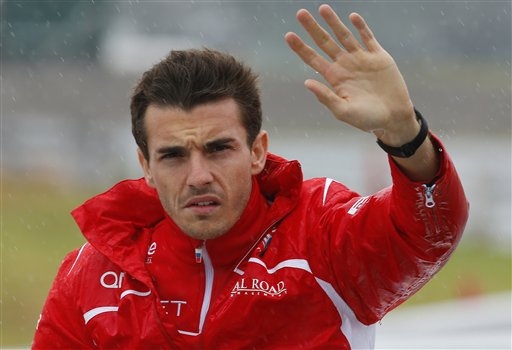
MONACO (AP) — The family of Jules Bianchi is taking legal action against motorsport's governing body, the Marussia team and Formula One Management following the French driver's death from head injuries.
Last July, Bianchi died after a long battle to recover from head injuries sustained in a head-on collision at the Japanese Grand Prix in October 2014. He was 25.
Bianchi's accident at Suzuka occurred at the end of the race in rainy, gloomy conditions, when his Marussia car slid off track and hit a crane picking up the Sauber of German driver Adrian Sutil, who had crashed at the same spot one lap earlier.
An investigation by FIA into the crash determined that a number of factors - the difficult racing conditions, Bianchi's elevated speed, and the presence of a crane - all contributed to the accident.
But Stewarts Law, a litigation-only law firm, said in a statement Thursday it has sent formal pre-action letters of claim to FIA, Marussia and FOM challenging these assertions.
"Jules Bianchi's death was avoidable. The FIA Panel Inquiry Report into this accident made numerous recommendations to improve safety in Formula One but failed to identify where errors had been made which led to Jules' death," said Stewarts Law partner Julian Chamberlayne, who is representing Bianchi's family. "It was surprising and distressing to the Bianchi family that the FIA panel in its conclusions, whilst noting a number of contributing factors, blamed Jules. The Bianchi family are determined that this legal process should require those involved to provide answers and to take responsibility for any failings."
The timing of the law suit coincides with the Monaco GP, where Bianchi secured his best-ever result with a ninth-place finish in 2014 for the unheralded Marussia team — then known as Manor Racing.
That impressive drive — with one of the least performant cars and on a track notoriously difficult to overtake on — underlined the widely held view within F1 that Bianchi was a star in the making, having been touted as future driver for Ferrari.
He was the first driver to die of injuries sustained in an F1 race since three-time world champion Ayrton Senna was killed at the 1994 San Marino Grand Prix, where Austrian driver Roland Ratzenberger also died during qualifying.
"We seek justice for Jules, and want to establish the truth about the decisions that led to our son's crash at the Japanese Grand Prix in 2014," Jules' father, Philippe Bianchi, said in the statement. "As a family, we have so many unanswered questions and feel that Jules' accident and death could have been avoided if a series of mistakes had not been made."
Bianchi's No. 17 was retired from F1 in honor of Bianchi, who grew up close to Monaco in nearby Nice — where his funeral was held. His parents have set up a charity in his memory to support young, aspiring motorsport drivers and will attend this weekend's Monaco GP.
In the first race after Bianchi's death, a poignant minute's silence was held before the start of the Hungarian Grand Prix, with drivers forming a ring and placing their race helmets on the ground.
Bianchi's parents, brother Tom and sister Melanie were asked by the drivers to join them in the ring as they all linked arms on the Hungaroring grid to remember Bianchi, while drivers wore tributes such as "Ciao Jules" or "JB 17" — Bianchi's initials and car number — on their helmets and cars.
French driver Romain Grosjean, who drives for the Haas team, is wearing a special helmet featuring graphics of Bianchi during this weekend's race.
"I remember him fondly," Grosjean said. "I want Jules to always be with us, and to be a part of our big family."
F1 is contemplating using closed cockpits, or protective halo devices around the cockpit area, in order to reduce the risk of serious injuries from crashes and also flying debris.